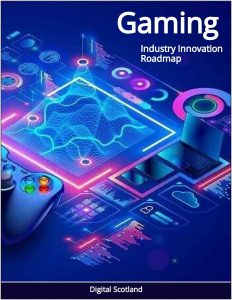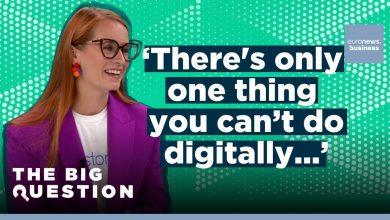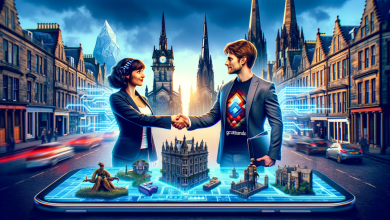 Scotland’s gaming industry, centered in Dundee and Edinburgh, is well-positioned to capitalize. With 80 studios and 2,000 professionals, the region produced hits like Grand Theft Auto and Lemmings.
Scotland’s gaming industry, centered in Dundee and Edinburgh, is well-positioned to capitalize. With 80 studios and 2,000 professionals, the region produced hits like Grand Theft Auto and Lemmings.
The metaverse offers opportunities to develop new IPs, attract investment, and create jobs.
Government initiatives, like the £3 million Digital Growth Fund, support innovation, while universities train talent in game design and XR technologies. Scottish firms could also tap into metaverse applications beyond gaming, such as virtual education and healthcare.
The metaverse, a digital realm blending virtual and augmented realities, is transforming gaming into a $560 billion market by 2030, per McKinsey projections. This convergence of gaming, social platforms, and immersive technologies offers vast economic potential, reshaping how players interact, create, and monetize experiences.
Defining the Metaverse in Gaming
The future market for metaverse gaming is expected to witness significant growth, forecast to grow to $563 billion by 2032. As technology continues to advance, more players will have access to immersive gaming experiences.
Metaverse gaming has the potential to transform the entertainment industry. Players can participate in virtual concerts, watch movies in virtual theaters, and attend virtual events. This opens up new opportunities for artists, musicians, and content creators to reach a global audience in innovative ways.
The metaverse in gaming extends beyond traditional play, creating persistent, interconnected virtual worlds where users socialize, work, and transact.
Unlike conventional games with linear narratives, metaverse platforms like Roblox, Fortnite, and The Sandbox enable user-generated content, fostering creativity and community. Blockchain technology and NFTs further enhance ownership, allowing players to trade unique digital assets, from virtual land to in-game items.
Gaming already generates $200 billion annually, surpassing film and music combined. The metaverse amplifies this, with estimates suggesting a $400–$560 billion market by 2030. Key drivers include immersive hardware like VR headsets, 5G connectivity, and cloud gaming, which reduce latency and enhance accessibility. In 2024, 3.4 billion gamers globally spent 1.5 trillion hours playing, a figure expected to grow as metaverse adoption rises.
Monetization and New Revenue Streams
Metaverse gaming introduces diverse revenue models. Beyond traditional game sales, platforms leverage in-game purchases, subscriptions, and advertising. Roblox, for instance, paid $1.2 billion to creators in 2023, showcasing the potential for user-driven economies.
Brands like Nike and Gucci are entering virtual spaces, selling digital products and hosting events, while play-to-earn models like Axie Infinity enable players to earn crypto-based rewards, particularly in developing regions.
The metaverse relies on advanced technologies. VR and AR hardware, like Meta’s Quest 3, deliver immersive experiences, with 20 million VR units sold by 2024. 5G networks ensure seamless connectivity, while AI enhances NPC interactions and procedural content generation. Blockchain secures digital ownership, enabling interoperable assets across platforms, though scalability remains a challenge.
Wilder World
Wilder World stands out as a prime example of the innovative games being crafted for the Metaverse, blending cutting-edge technology with immersive, player-driven experiences.
It’s a massively multiplayer online (MMO) game that positions itself as a “5D Metaverse,” built on Ethereum, Unreal Engine 5, and ZERO technology. Unlike traditional games, Wilder World isn’t confined to a single gameplay style—it’s a sprawling, decentralized virtual universe where players can engage in diverse activities like high-speed racing, first-person shooter (FPS) combat, role-playing adventures, and resource mining, all within a photorealistic open world called Wiami.
Wiami, the game’s first city, is a futuristic, cyberpunk-inspired metropolis modeled as a 1-to-1 geographical replica of Miami, Florida, but reimagined with a solarpunk ethos and 1980s flair.
Spanning a map 13.5 times larger than Grand Theft Auto V’s, it offers a scale and detail that push the boundaries of virtual environments.
This isn’t just a backdrop; it’s a living ecosystem where players can own, trade, and customize digital assets—avatars, vehicles, land parcels—as Non-Fungible Tokens (NFTs) via the Wilder World Metaverse Market (WWMM). This integration of blockchain technology ensures true ownership and economic agency, a hallmark of Metaverse gaming that sets it apart from conventional titles.
The gameplay itself reflects the Metaverse’s promise of interoperability and freedom. Wilder World offers multiple core modes—racing, combat, RPG, and mining—that can be played standalone or interwoven within the open world. For instance, players might race customized vehicles in a high-stakes challenge, then pivot to FPS combat against an authoritarian regime called FORUM, all while earning and spending the native $WILD token.
This token fuels the in-game economy, from buying fuel for races to upgrading weapons, and ties into a play-to-earn model that rewards skill and participation. The decentralized governance aspect further empowers players, letting them shape Wiami’s rules and future through community-driven decisions.
What makes Wilder World a poster child for Metaverse gaming is its ambition to merge AAA-quality visuals (thanks to Unreal Engine 5) with Web3 principles—decentralization, player ownership, and an open economy.
The Future of Metaverse Gaming
Despite its promise, the metaverse faces hurdles. High development costs, with AAA games now exceeding $200 million, strain smaller studios. Interoperability issues hinder seamless cross-platform experiences, and regulatory concerns around data privacy, digital currencies, and child safety loom large.
User retention is another issue—platforms like Decentraland have struggled with engagement, reporting fewer than 1,000 daily active users in 2024. Environmental concerns also arise, as blockchain and cloud computing demand significant energy.
By 2030, the metaverse could integrate seamlessly with daily life, with 700 million monthly active users projected across major platforms. Innovations like brain-computer interfaces and haptic suits may deepen immersion, while AI-driven worlds evolve dynamically. For Scotland and the global industry, success hinges on overcoming technical, regulatory, and ethical challenges while fostering creativity and inclusivity.
In conclusion, metaverse gaming represents a transformative economic and cultural force. With a potential $560 billion market, it offers unprecedented opportunities for innovation, monetization, and community-building. Scotland’s gaming ecosystem, backed by talent and infrastructure, can play a pivotal role in shaping this digital frontier, provided it navigates the complexities ahead.



